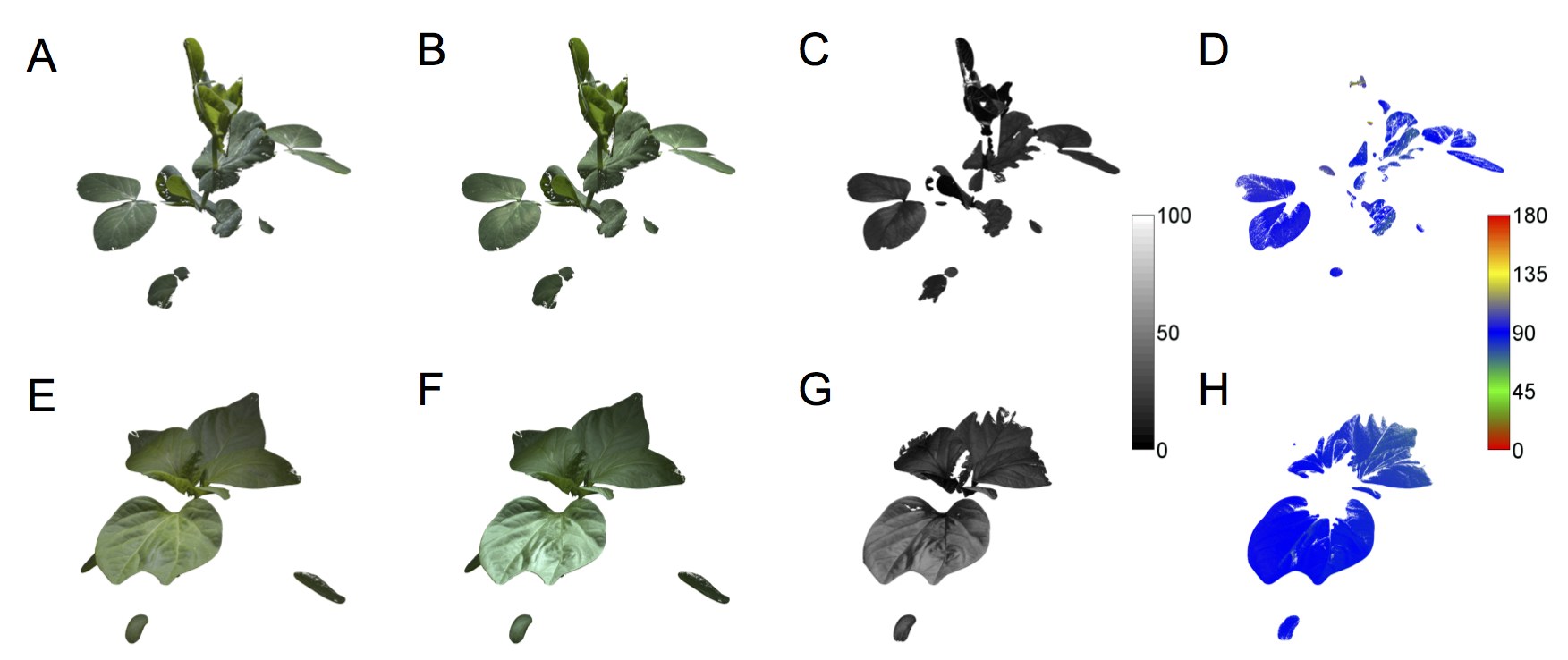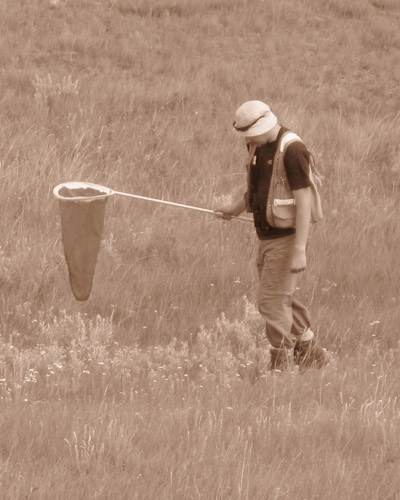You might be wondering where Figure 1 was taken and what it has to do with polarized light. The picture shows an unfortunate water boatman that landed on the roof of my car and quickly succumbed to the high temperatures of the sun baked metal. Why would this aquatic insect be landing on a car in the first place? The answer has to do with polarized light.
Just as every ray of light has a specific wavelength, each ray also oscillates in a particular direction perpendicular to its direction of travel (Fig. 2). This direction is known as the axis of polarization and is measured as an angle between 0 and 180°. When the rays of light from a light source are oscillating in different directions, light is said to be unpolarized. Sunlight and the light from most artificial light sources are unpolarized, at least initially (Johnsen 2012). Polarized light oscillates in only one direction (Fig 2). Most light is a mixture of polarized and unpolarized light and the ratio of the two is measured as a percentage known as the degree of polarization. So how does unpolarized light from the sun and other light sources become polarized? This polarization occurs through two main processes. The first of these is scattering by molecules in air or water (Johnsen 2012). This is the same type of scattering that produces the blue sky. This scattering produces a band of polarized skylight at a 90° angle from the sun. This will become important when we talk about insect navigation. The other mechanism that produces polarized light is mirror-like reflection from smooth shiny surfaces like those on water, glass or leaves (Johnsen 2012; and Fig. 2). After being reflected, this light has an axis of polarization parallel to the reflecting surface.
You can directly observe both of these phenomena using a pair of polarized sunglasses and twisting your head back and forth. These sunglasses and most other polarizing filters work by using parallel sheets of long polymers that better absorb light oscillating parallel to the long axis of the polymers (Johnsen 2012). In sunglasses these polymers are oriented so that they will block horizontally polarized light (axis of polarization of 90°). You can roughly estimate the axis of polarization (Fig. 3 D, H) of light by twisting a polarizing filter to minimize the observed intensity (Fig. 3 A, E). The angle of the filter at this point will be parallel to the axis of polarization. Twisting the filter by 90° should maximize the intensity transmitted (Fig. 3 B, F). By comparing the intensities you can then estimate the degree of polarization (Fig. 3 C, G) with greater differences indicating a larger degree of polarization.
The insect visual system, unlike that of vertebrates, is inherently sensitive to polarized light (Horváth & Varjú 2004). Like the polymers in polarized sunglasses, the visual pigments present in both vertebrate and invertebrate photoreceptors better absorb light with an axis of polarization parallel to the long axis of the pigment molecule (Johnsen 2012). What then prevents polarized light sensitivity in vertebrates? It all has to do with the organization and orientation of membranes. Because visual pigments are membrane proteins the pigment molecule can only rotate in the plane of the membrane. The finger-like microvilli forming the rhabdom of insect photoreceptors constrain the rotation of these pigments resulting in greater absorbance of light with an axis of polarization parallel to the microvilli (Horváth & Varjú 2004). In vertebrates the rotation of pigments is not constrained within microvilli and as a consequence vertebrate photoreceptors are not generally sensitive to polarized light. The predisposition of insect receptors to sensitivity to polarized light may result in impaired color sensitivity as both spectral and polarization sensitivities can affect the response of a photoreceptor, resulting in what is known as polarization induced false colors (Horváth & Varjú 2004). To avoid this, many insects have a gradual twist along their photoreceptor that reduces the overall sensitivity to polarized light (Horváth & Varjú 2004).
How then do insects utilize this sensitivity to polarized light? The most well studied example is navigation using the pattern of polarization in the sky. Many insects have a specialized region at the very top of the compound eye known as the dorsal rim (Labhart & Meyer 1999). This area has photoreceptors that are particularly sensitive to polarized light. By comparing the response both among photoreceptors in the same ommatidium and between adjacent ommatidia, the insect is able to determine direction through the use of a polarization compass (Horváth & Varjú 2004). This has been best studied in honeybees (Apis mellifera), desert ants (Cataglyphis bicolor), and desert locusts (Schistocerca gregaria).
What has been relatively less well studied is the use of polarized sensitivity outside of the dorsal rim. One common use for this sensitivity is the use of horizontally polarized light by a wide variety of aquatic insects as a cue to identify water (Horváth & Varjú 2004). This brings us back to the unfortunate water boatman (Fig. 1). This aquatic insect like many others was attracted to one of many anthropogenic surfaces like vehicles, wet asphalt, glass, black plastic or oil slicks that strongly reflect horizontally polarized light (Horváth et al. 2009). In addition to the direct mortality from landing on hot vehicle surfaces (Fig. 4) or in oil pools, anthropogenic sources of polarized light can have further negative consequences when aquatic insects oviposit on these surfaces (Horváth et al. 2009).
This brings me to the topic of my PhD thesis, where I am investigating the use of polarized light as an oviposition or foraging cue in phytophagous insects. The idea that phytophagous insects utilize differences in the degree of polarization as a cue to recognize their host plants has been hypothesized (Kelber et al. 2001) but remains untested. If this is in fact the case we expect that (1) there will be variation among plants in their reflection of polarized light, (2) insects will be able to perceive these differences, and finally (3) these differences will affect their host choice. Different plant species have leaf surfaces with different characteristics (e.g., wax, hairs) and these characters create differences in the amount of polarized light they reflect (Grant et al. 1993; and Fig. 2). As mentioned previously, insect visual systems are inherently sensitive to polarized light and for this reason its possible that a great many insects might be sensitive to polarized light from plants. My current experiments are investigating the third prediction using behavioral bioassays where we manipulating the polarized reflection from plants in an attempt to influence host plants choice.
In conclusion sources of polarized light are common in both natural and anthropogenic settings and sensitivity to this polarized light seems to be equally common among insects. Something worth considering when pondering navigation, habitation selection, or host selection in insects.
Further Reading
For a more thorough introduction to polarized light I would recommend the chapter on polarization in Johnsen (2012) while Horváth & Varjú (2004) offer an extensive review of polarized light in animal vision.
Acknowledgements
I would like to thank the invaluable contribution of my undergraduate research assistants Samuel Couture & Matthew C. Go; Gerhard Gries, my supervisor; and, as always, my wife Sara who provided both moral and editorial support. The Natural Sciences and Engineering Research Council of Canada (NSERC) – Industrial Research Chair, with Scotts Miracle-Gro Canada as industrial sponsor, supported this research.
References
Grant, L., Daughtry, C.S.T. and Vanderbilt, V.C., 1993. Polarized and specular reflectance variation with leaf surface features. Physiologia Plantarum, 88:1-9.
Horváth, G. and Varjú, D., 2004. Polarization patterns in nature and polarized light in animal vision. Springer, New York.
Horváth, G., Kriska, G., Malik, P. and Robertson, B., 2009. Polarized light pollution: a new kind of ecological photopollution. Frontiers in Ecology and the Environment, 7:317-325.
Johnsen, S., 2012. The optics of life: a biologist’s guide to light in nature. Princeton University Press. Princeton, New Jersey.
Kelber, A., Thunell, C. and Arikawa, K., 2001. Polarisation-dependent colour vision in Papilio butterflies. Journal of Experimental Biology, 204:2469-2480.
Labhart, T. and Meyer, E.P., 1999. Detectors for polarized skylight in insects: a survey of ommatidial specializations in the dorsal rim area of the compound eye. Microscopy Research and Technique, 47:368-379.
This post was originally prepared as a special feature for Bulletin of the Entomological Society of Canada (48(1):7-10). Figure 1 was awarded 1st prize during the 2015 joint annual meeting of the Entomological Society of Canada (see Bull. of the Ento. Soc. Can. 47(4): 137).






Follow Me